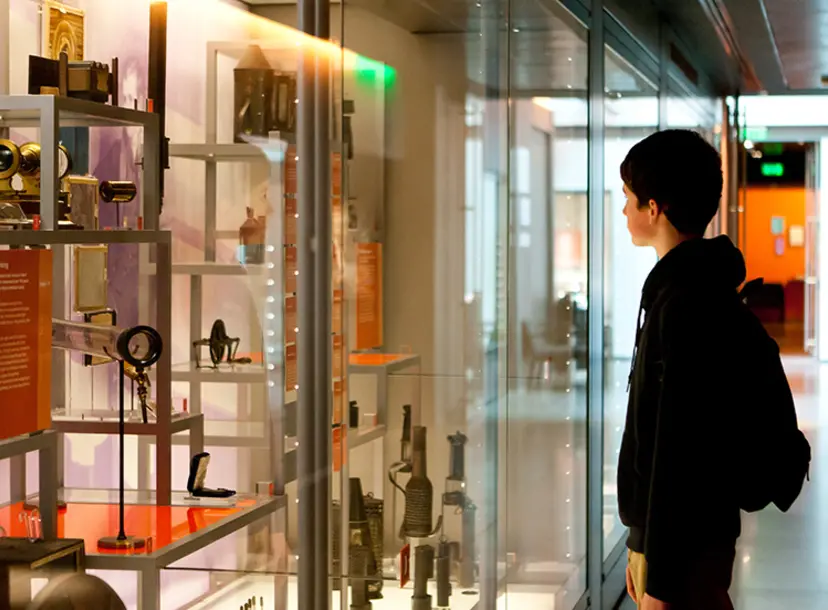The Royal Institution building in Central London stands on over 223 years of science history. 10 chemical elements were discovered or isolated by scientists working at the Ri, and countless scientific inventions were made here – from the world's first electric motor to the lamp that saved thousands of lives.
It's hard to pick just a handful from the myriad of fascinating original objects on display, but consider this an appetiser for what is a holiday feast of historical records (we are the home of the CHRISTMAS LECTURES, after all).
Michael Faraday’s electric magnetic rotation apparatus (motor)
Sat on a workbench in Faraday's magnetic laboratory lives an unassuming object, so simple in design you might just miss it when taking in the breadth of Faraday’s workspace, but you would most certainly regret it. This unique object dating from 1822 (the year following the invention) is the only surviving Faraday apparatus, built by his own hand, and displayed in the very lab it was created.
In the 1820s, Michael Faraday set about trying to understand the previous work of scientists Hans Christian Ørsted and André-Marie Ampère. He was the first to understand the implications of their discoveries around electricity and magnetic forces. If a magnetic pole could be isolated, it ought to move constantly in a circle around a current-carrying wire.
Faraday devised his own experiment using a small mercury bath, this device, which transformed electrical energy into mechanical energy, was the first electric motor.
How does it work?
The motor features a stiff wire which hangs down into a glass vessel which has a bar magnet secured at the bottom. The glass vessel would then be part filled with mercury (a metal that is liquid at room temperature and an excellent conductor).
Faraday connected his apparatus to a battery, which sent electricity through the wire creating a magnetic field around it. This field interacted with the field around the magnet and caused the wire to rotate clockwise.
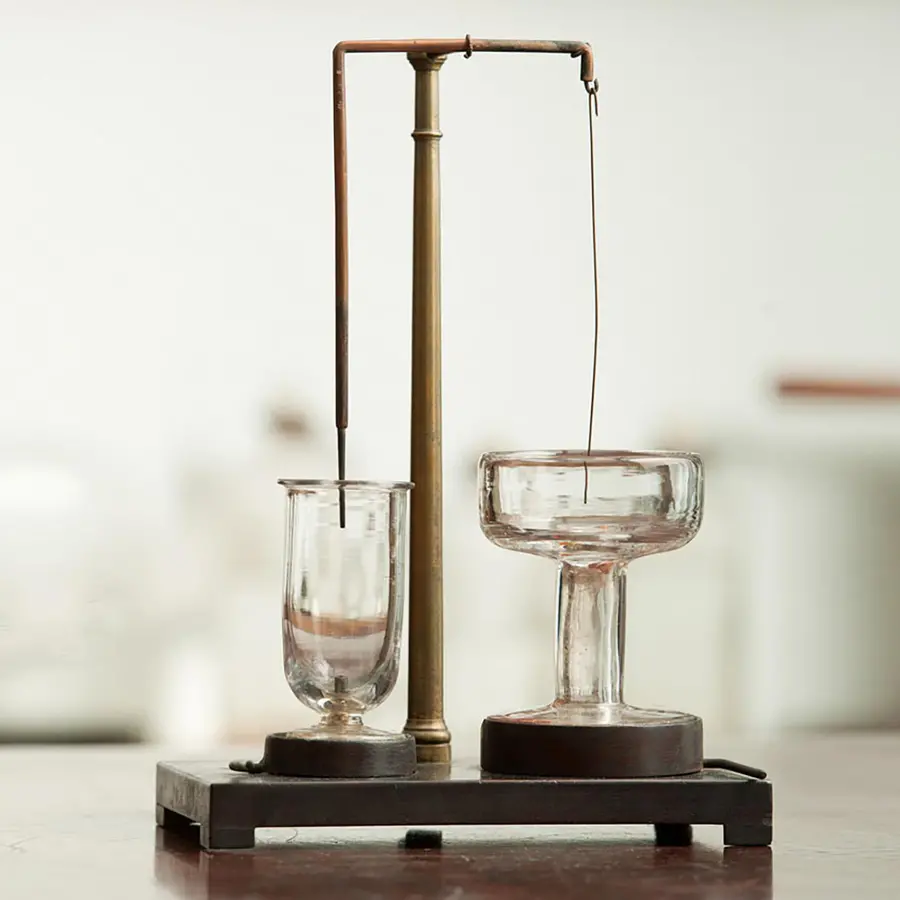
Alessandro Volta’s voltaic pile
Today we take the easy availability of portable electric power for granted, from the phones in our pockets to the electric cars on our roads. But we wouldn’t have got very far without the work of Alessandro Volta.
The first electrical battery was invented by Volta in 1800 in Genoa,Italy and is named the voltaic pile. The example you can see on display in our Faraday Museum is an early example of a chemical battery (made before 1813) and was presented by Volta himself to Faraday in 1814.
How does it work?
The chemical battery is made up of a stack of plates of two different metals on a wooden base held in place by three glass rods and sandwiched with blotting paper. To use the battery the paper was soaked in acid, creating an electric current between the top and bottom of the battery.
What happened next?
Humphry Davy made his first major scientific discoveries at the Royal Institution in the new field of electrochemistry in the early 1800s, with science that stemmed from Volta’s invention of the electric battery.
Experimenting with these batteries Davy developed the first coherent theory of electrochemical action and, for the first time, he isolated chemical elements including sodium and potassium.

Kathleen Lonsdale and x-ray crystallography
Using the process of x-ray crystallography, Kathleen revealed the shape of the benzene ring – a molecular scaffold whose unusual chemical properties were considered a mystery to chemists for decades.
Kathleen used photographs taken right here at the Royal Institution, which showed the benzene ring’s dimensions and atomic structure.
What is x-ray crystallography?
X-ray crystallography reveals the structure of matter at the atomic level. The process involves exposing a crystallised sample of a molecule to x-rays and the resulting photograph shows the pattern of diffracted x-rays as they passed through the crystal. Scientists, such as Kathleen Lonsdale, can then visually map the molecular structure using mathematics.
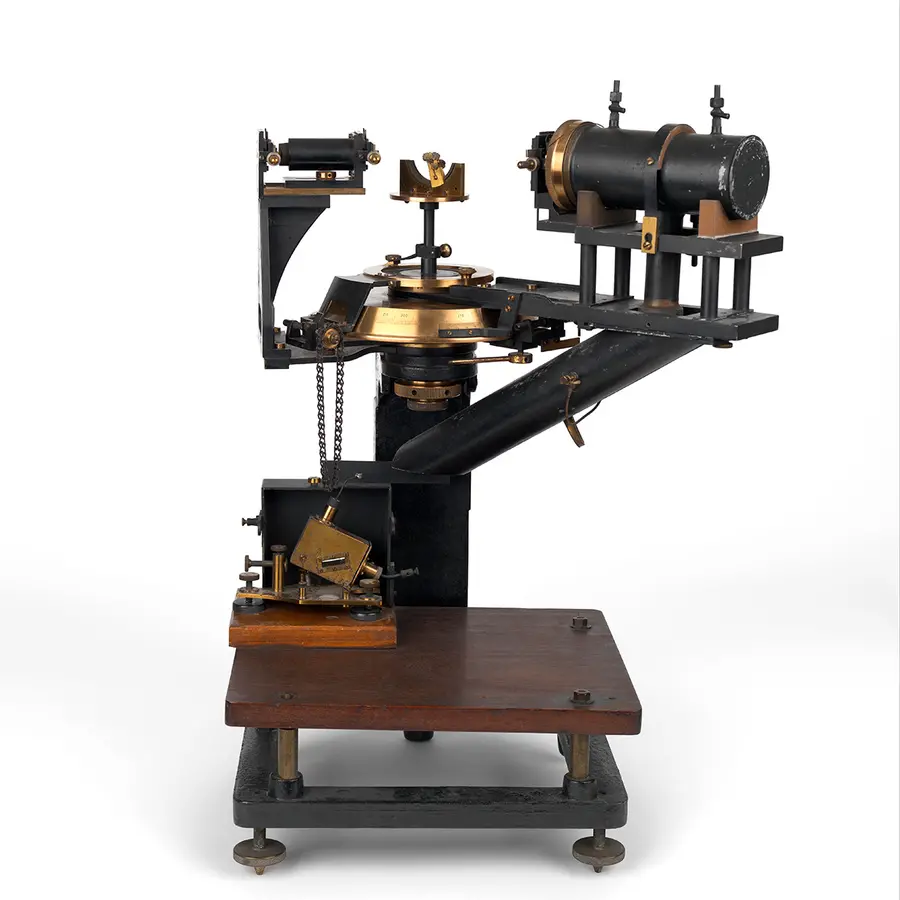
Humphry Davy’s miners’ safety lamp
Following a number of serious explosions in north-east coal mines due to pockets of flammable gas known as ‘firedamp’, Humphry Davy was tasked to find a means of lighting coal mines safely.
The result? The miners’ safety lamp.
We have several examples of the miners’ safety lamp on display in our Faraday Museum, including his first-ever prototype.
Created in our very own basement laboratory in 1815, it was designed to be lit safely for miners to use without allowing the heat from the flame to explode the concentration of methane gas often found as miners dug deeper.
How does it work?
After testing several possibilities, Davy’s final design was very simple: a basic lamp with a wire gauze chimney enclosing the flame. The holes let light pass through, but the metal of the gauze absorbs the heat.
The lamp is safe to use because the flame can't heat enough flammable gas to cause an explosion, although the flame itself will change colour.
What happened next?
After its introduction, fatalities decreased enormously, and also made a fundamental contribution to an industrialised Britain by increasing coal production.
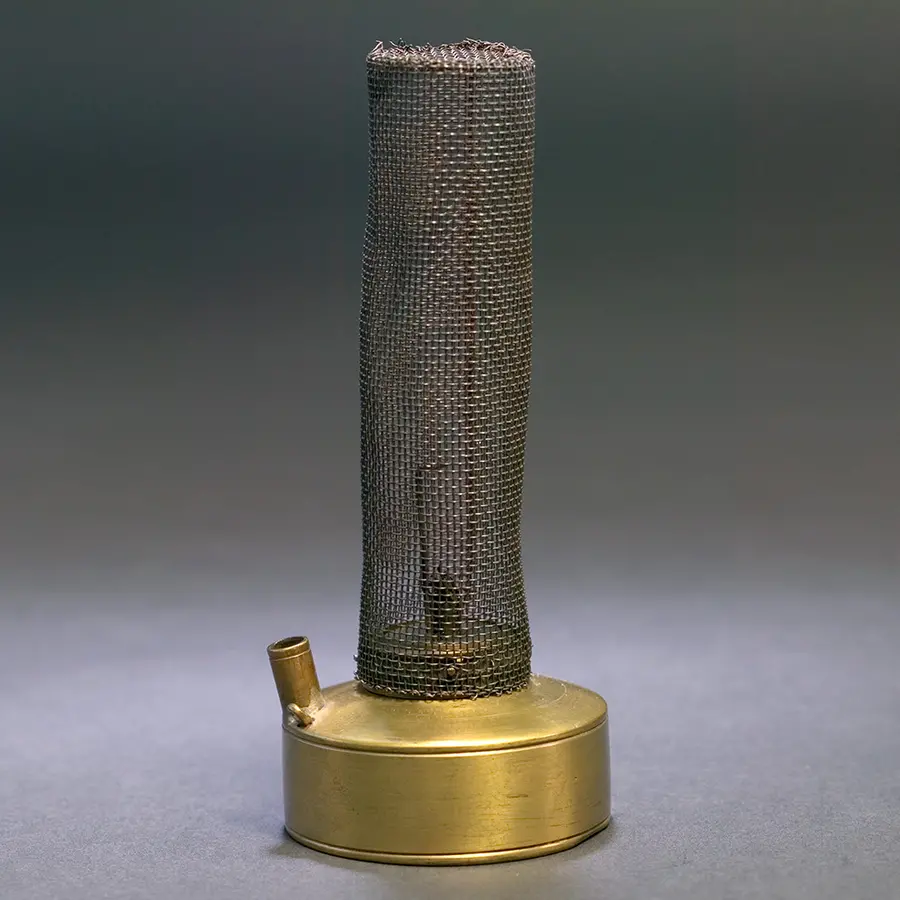
James Dewar’s vacuum flask
Picture this, you’re halfway through an afternoon hike across the countryside but you could really do with a cuppa. Without a café in sight, you start to panic, until your walking mate pulls out their trusty Thermos. Breathing a sigh of relief, you pour yourself a lovely hot cup of tea. Phew!
Without the work of James Dewar and this next object, you might have been utterly scuppered.
During the course of his cryogenic research, Dewar invented the vacuum flask, which could hold liquefied gases at extremely low temperatures. We have his first-ever flask on display in the museum, which he created in 1892.
How does it work?
This vessel consists of glass flasks fitted one inside the other and sealed at the neck with a partial vacuum between them. The central flask is therefore insulated, keeping the contents cold and slowing down evaporation.
How does it relate to a cup of tea?
Dewar never patented his invention of the flask. It was patented and renamed for industrial use in 1904 by the Thermos company, set up by two German glassblowers who recognised its potential to keep liquids warm as well as cool.
The Thermos is still a household name to this day, and remains the thirst-quenching saviour of many a stroll or picnic.
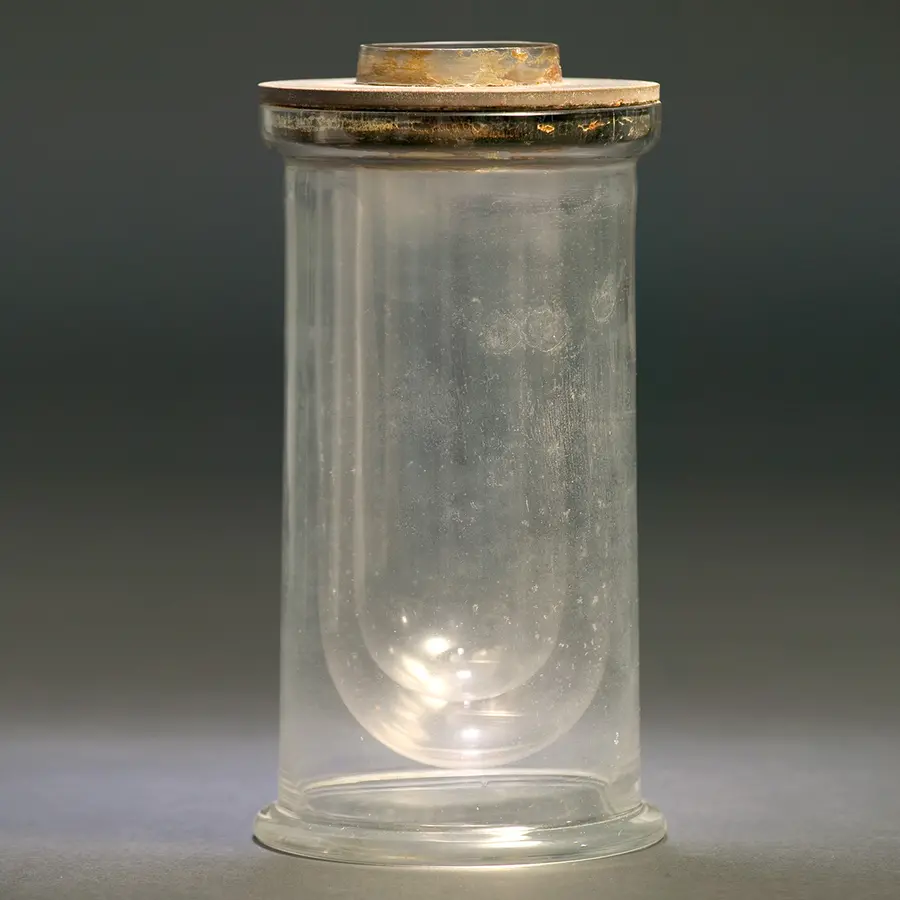
Michael Faraday’s sample of benzene
A small vial sits on a shelf in our collection at the Faraday Museum, this vial contains Faraday’s sample of benzene. A colourless liquid with a sweet smell, Faraday successfully isolated the substance for the first time in 1825.
What is it?
Benzene is a natural hydrocarbon and a component of crude oil. Faraday was interested in an oily residue that was created as a by-product of the production of 'portable gas'.
Faraday was interested in the liquid, which formed when the gas was pressurised. He experimented with distilling this mixture and, as he reported in a paper to the Royal Society on 16 June, he ‘succeeded in separating a new compound of carbon and hydrogen, which I may by anticipation distinguish as bi-carburet of hydrogen’
By the 19th century, benzene was manufactured on an industrial scale from coal tar. At first it was mainly used as a solvent for degreasing engines but was quickly integrated into daily life, with everything from aftershave lotions to part of the process of making decaffeinated coffee.
What happened next?
The structure of benzene has been the subject of much research. Many theories were put forward throughout the 19th century, but it wasn’t until 1925, a century after its discovery by Faraday, that scientist Kathleen Lonsdale finally unlocked the secret using x-ray crystallography.
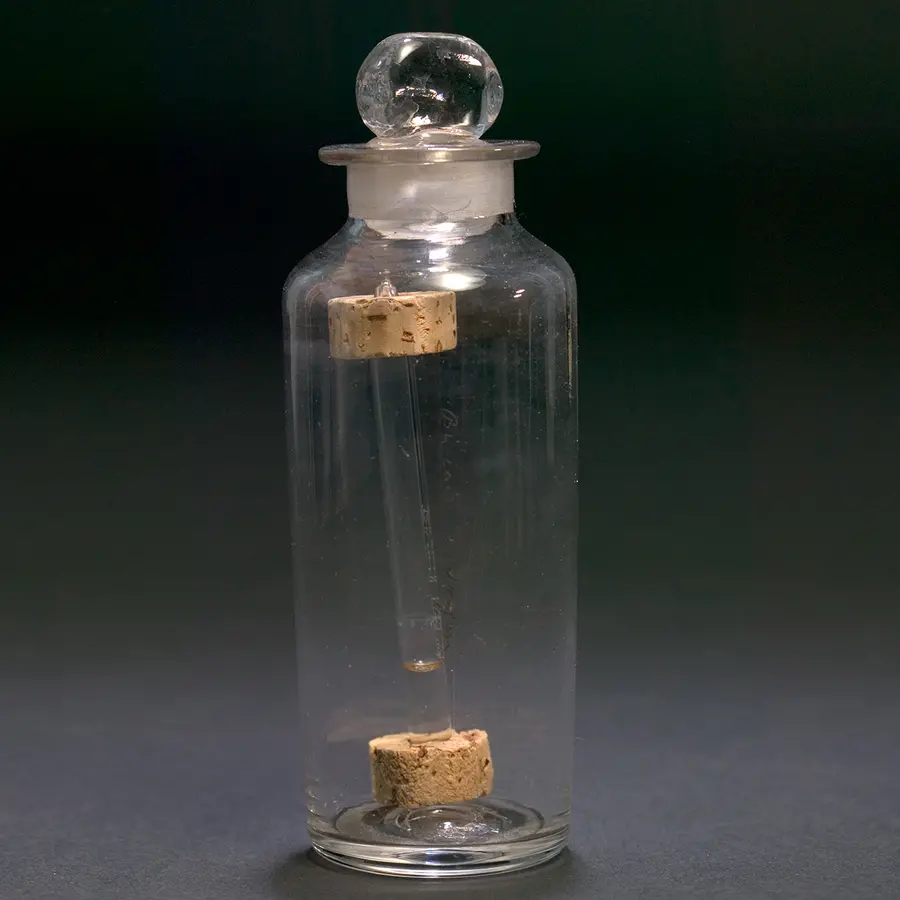
Over 200 years of history-making science
The Faraday Museum is a hidden gem in the heart of London, and it's absolutely free to visit.
See all the objects above, plus many more. Find out about the 14 Nobel Prize winners who have worked at the Ri, or try your hand at our hands-on chemical elements game.
Our usual opening hours are Monday to Friday 9.00am – 5.00pm (excluding public holidays), though we recommend checking for closures, which may be due to events taking place.
You can find the main exhibition on the lower ground floor, but the museum stretches across all the three public floors of the Ri. Click the button below to find out more.
